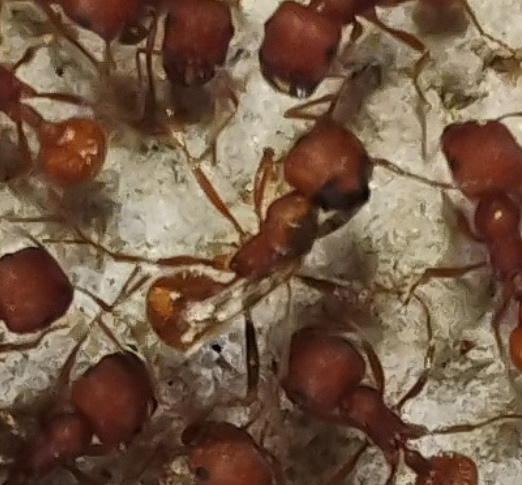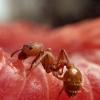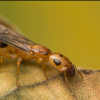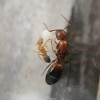- Formiculture.com
- Forums
- Gallery
- Members
- Member Map
- Chat

Is this normal? Has anyone ever seen this before?
Started By
Ugo77
, Today, 10:20 AM
3 replies to this topic
#1
 Offline
-
Posted Today, 10:20 AM
Offline
-
Posted Today, 10:20 AM
I noticed something really strange in my ant colony today. One of the workers had two fully developed heads on a single body. Both heads were moving independently, and the ant had trouble walking straight — it kept spinning or changing direction suddenly.
It looked like a rare developmental defect, maybe like conjoined twins. I’ve never seen this before.
It disappeared into the test tube a few minutes later and I haven’t seen it again since.
Has anyone here ever observed something like this in their colony?
I posted a video on Reddit here : https://www.reddit.c...ng/s/qox1uj38tz
It looked like a rare developmental defect, maybe like conjoined twins. I’ve never seen this before.
It disappeared into the test tube a few minutes later and I haven’t seen it again since.
Has anyone here ever observed something like this in their colony?
I posted a video on Reddit here : https://www.reddit.c...ng/s/qox1uj38tz
- eea likes this
#2
 Offline
-
Posted Today, 11:19 AM
Offline
-
Posted Today, 11:19 AM
Conjoined twins and other such mutations are for sure not the typical situation to expect. Though i would point out everything on a bell curve from middle bell common to way down the side of the bell rare, is all 100% normal.
Mutations are a normal occurrence around here for all life forms, some mutations are just much more rare than others, and these mutations are the side of bell odds to hit, not the typical middle bell odds payouts.
But like the hard-way bets on a craps table, normal is they are possible to pay out, typical is they do not.
Jus say'n, it's an important distinction. "Normal" can be a bit of a dangerous/easily misunderstood word to use. I stick to saying "typical" or "common"
and "atypical" or "uncommon." In order to avoid the mental baggage that can come with the term "normal" for a lot of people.
I just posted this one the other day,

which was identified for me as the "supergene" mutation where traits of distinctly separate DNA code are being expressed simultaneously.
#3
 Offline
-
Posted Today, 2:04 PM
Offline
-
Posted Today, 2:04 PM
Conjoined twins and other such mutations are for sure not the typical situation to expect. Though i would point out everything on a bell curve from middle bell common to way down the side of the bell rare, is all 100% normal.
Mutations are a normal occurrence around here for all life forms, some mutations are just much more rare than others, and these mutations are the side of bell odds to hit, not the typical middle bell odds payouts.
But like the hard-way bets on a craps table, normal is they are possible to pay out, typical is they do not.Jus say'n, it's an important distinction. "Normal" can be a bit of a dangerous/easily misunderstood word to use. I stick to saying "typical" or "common"
and "atypical" or "uncommon." In order to avoid the mental baggage that can come with the term "normal" for a lot of people.
I’ve seen a handful of ants like the worker that FullFrontalYeti is showing us on the internet, I even ran into an alate with this mutation recently believe it or not, where she was part drone and part alate but the “mutation” or whatever you want to call it that but the ant that Ugo is showing us is very peculiar, I counted around 9, maybe 10 legs one that odd little ant, something that I have never even come across ever, online and in real life. Certainly something that has scientific value because I have never even seen or heard of the idea or “conjoined twins” in insects. I’d also like to say that on the Antkeeping section on Reddit, most people will comment something that doesn’t really answer when there is a question that requires a more professional answer, and very rarely I have seen someone with profound ant knowledge responding to questions like yours on Reddit, but I do think that (maybe) here you’ll at least get some more “professional” answers here, but who knows someone could pop up anywhere with a credible answer.
Also have you thought about contacting an entomologist? The responses you got on Reddit about preserving the worker is actually not a bad idea because I had a worker with defects in my Formica colony and it disappeared the next day because she was dismantled and eaten. Hopefully the reason why you can’t find her anymore is not because she was killed by the other workers.
Edited by OwlThatLikesAnts, Today, 2:06 PM.
Currently keeping:
1x Formica subsericea, 35-40 workers + maybe eggs
1x Crematogaster cerasi, only queen now, workers ded ![]() *internal screaming*
*internal screaming*
1x Myrmica ruba sp around 10 workers + pupa
*New* 1x founding Camponotus pennsylvanicus + eggs that die (probably infertile)
*New* 2x Camponotus nova, one is infertile
*As you watch your ants march, remember that every thing begins with a small step and continued by diligence and shared dreams*
-A.T (which is Me)
#4
 Offline
-
Posted Today, 4:25 PM
Offline
-
Posted Today, 4:25 PM
Thank you for posting it here! The moment I saw your post on Reddit my first thought was "this belongs on Formiculture".
To be honest, this is so cool to me. I'm glad you made an account! This forum is great, and a well of information. Enjoy your stay
To be honest, this is so cool to me. I'm glad you made an account! This forum is great, and a well of information. Enjoy your stay
Edited by Flu1d, Today, 4:25 PM.
- ANTdrew likes this
1 user(s) are reading this topic
0 members, 1 guests, 0 anonymous users
















